|
|
|
Sort Order |
|
|
|
Items / Page
|
|
|
|
|
|
|
| Srl | Item |
| 1 |
ID:
130702
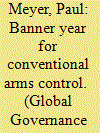

|
|
|
|
|
| Publication |
2014.
|
| Summary/Abstract |
THE CONTROL OF CONVENTIONAL ARMS HAS OFTEN SEEMED THE POOR COUSIN of the global efforts to control weapons of mass destruction (WMD). Since the advent of the atomic era, the focus of arms control and disarmament activity has been overwhelmingly on nuclear weapons and their lesser, if still ugly, stepsisters of biological and chemical weapons. The initial multilateral arms control agreements concerned themselves with limits on the testing of nuclear weapons and, shortly thereafter, with their nonproliferation (e.g., the Nuclear Nonproliferation Treaty of 1968). Bilateral US-Soviet/Russian arms control arrangements also predominantly dealt with the reduction of strategic nuclear forces and restraints on deployments of defenses against (nuclear tipped) ballistic missiles. Efforts to reduce major conventional weapon systems were also taken up in the 1980s in the context of negotiations
between the opposing alliances of NATO and the Warsaw Pact, eventually culminating in the Treaty on Conventional Forces in Europe (CFE Treaty) of 1989. This treaty provided for a massive reduction in the conventional forces that had confronted each other for years in Central Europe and established a new, far more stable security order on the continent. Even the CFE Treaty, however, tended to be overshadowed by other major disarmament agreements concluded in those heady post-Cold War days: the Intermediate Nuclear Forces Treaty (1987), Chemical Weapons Convention (1993), Comprehensive (Nuclear) Test Ban Treaty (1996), and various US-Russian bilateral strategic nuclear arms accords of the 1990s and early 2000s (e.g., the Strategic Arms Reduction Treaty and the Strategic Offensive Reductions Treaty).
|
|
|
|
|
|
|
|
|
|
|
|
|
|
|
|
| 2 |
ID:
132148
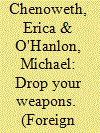

|
|
|
|
|
| Publication |
2014.
|
| Summary/Abstract |
Over the past three years, the world has witnessed a surge of nonviolent resistance movements. Pictures of huge demonstrations in public squares have become a staple of international news broadcasts, and Time named "the protester" as its Person of the Year for 2011. These days, it seems that at any given moment, thousands of people are mobilizing for change somewhere in the world.
|
|
|
|
|
|
|
|
|
|
|
|
|
|
|
|
| 3 |
ID:
132785
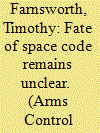

|
|
|
|
|
| Publication |
2014.
|
| Summary/Abstract |
A new draft of the European Union's proposed international code of conduct for activities in outer space was released during a May 27-28 meeting in Luxembourg, but despite the revisions, it is unclear which countries will support the code.
"We are fully aware that [the current draft] does not meet the concerns and expectations of all," Jacek Bylica of the EU, chairman of the meeting, said in his closing remarks.
The meeting was the last of a series of three consultations that began in Kiev in May 2013 and continued in Bangkok in November 2013. The meetings represented an effort to expand the group of negotiating states beyond the established spacefaring countries. (See ACT, May 2013.) During the three meetings, officials from more than 80 countries met to discuss elements of a code, with many disagreements remaining throughout the process
|
|
|
|
|
|
|
|
|
|
|
|
|
|
|
|
| 4 |
ID:
130351
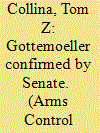

|
|
|
|
|
| Publication |
2014.
|
| Summary/Abstract |
In the face of accusations that the administration had withheld information from Congress on possible Russian Violations of an arms treaty, the Senate on March 6 voted to confirm President Barack Obama's choice to be his top arms control official. Rose Gottemoeller, first nominated in September 2012 to replace Ellen Tauscher as undersecretary of state for arms control and international security, had been serving as acting undersecretary and as assistant secretary for arms control, verification, and compliance. She was the main U.S. negotiator of the New Strategic Arms Reduction Treaty (New START), which the Senate approved in December 2010. The Senate approved Gottemoeller's nomination by a nearly party-line vote, 58-42, with the support of 50 Democrats, six Republicans, and two independents. Three Democrats and 39 Republicans were opposed. The Republicans voting for Gottemoeller were Lamar Alexander (Tenn.), Susan Collins (Maine), Bob Corker (Tenn.), Jeff Flake (Ariz.), Johnny Isakson (Ga.), and Lisa Murkowski (Alaska). The Democrats opposing her were Heidi Heitkamp (N.D.), Jon Tester (Mont.), and John Walsh (Mont.). After being approved twice by the Senate Foreign Relations Committee, once last October and again in February, Gottemoeller's nomination was held up by Sen. Marco Rubio (R-Fla.) and others over concerns that the administration had dragged its feet in informing them about Russia's possible violation of the 1987 Intermediate-Range Nuclear Forces (INF) Treaty. (See ACT, March 2014.) In a Feb. 28 statement, Rubio and Sens. John Cornyn (R-Texas) and James Risch (R-Idaho) accused Gottemoeller of "failing to quickly pursue evidence of Russia's [non]compliance with multiple arms control agreements and her delay in making the Senate aware of these violations." The three senators also said they were "frustrated" that the administration did not make a written commitment that "any future U.S. nuclear reductions would be carried out only through a treaty subject to the advice and consent of the Senate" and not by unilateral or other means that did not involve a treaty, such as reciprocal reductions carried out by the United States and Russia in 1991. At Gottemoeller's confirmation hearing Sept. 26, Rubio pressed her on the issue of unilateral cuts. Gottemoeller replied that the administration had already begun to pursue an arms control treaty with Russia, a process she described as "a difficult slog." She said that "unilateral reductions are not on the table," but did not rule them out in the future. (See ACT, November 2013.)
|
|
|
|
|
|
|
|
|
|
|
|
|
|
|
|
| 5 |
ID:
132416
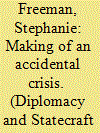

|
|
|
|
|
| Publication |
2014.
|
| Summary/Abstract |
This analysis re-examines the Carter Administration's formulation of policy on the theatre nuclear force issue following the neutron bomb affair. It demonstrates that European leaders did not foist the arms control component of the NATO dual-track decision on Jimmy Carter. Rather, the Carter Administration understood the merits of an arms control component following the August 1978 PRM-38 review and thought that Soviet-American arms control negotiations would play a crucial role in resolving the conflict between NATO and the Warsaw Pact over theatre nuclear forces. This analysis also considers the previously unexamined interactions between the United States and the Soviet Union in the months leading to the dual-track decision. It reveals that American officials underestimated the degree of Soviet anger over the dual-track decision, believing that arms control negotiations with the Soviets on theatre nuclear forces would be possible and productive. The Carter Administration did not foresee the Euromissiles crisis.
|
|
|
|
|
|
|
|
|
|
|
|
|
|
|
|
| 6 |
ID:
132783
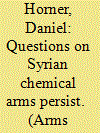

|
|
|
|
|
| Publication |
2014.
|
| Summary/Abstract |
Efforts to resolve several issues arising from Syria's chemical weapons program appear to be moving slowly, even as the destruction of Syrian chemical weapons material aboard a U.S. ship in the Mediterranean Sea began this month.
Officials from the Organisation for the Prohibition of Chemical Weapons (OPCW) and some of its key member states have highlighted the need for Syria to destroy its chemical weapons production facilities and resolve questions about its declaration of its arsenal last year.
For months, Robert Mikulak, the U.S. ambassador to the OPCW, has been castigating Syria for its failure to destroy its 12 remaining former chemical weapons production facilities. Destruction of such facilities is a required step under the Chemical Weapons Convention (CWC), which Syria joined last fall. Under a timetable for chemical weapons destruction approved by the OPCW Executive Council last November, that task was to be completed by March 15.
|
|
|
|
|
|
|
|
|
|
|
|
|
|
|
|
| 7 |
ID:
132782
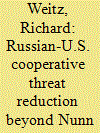

|
|
|
|
|
| Publication |
2014.
|
| Summary/Abstract |
The crisis in Ukraine probably has ruined prospects for another formal Russian-U.S. arms control agreement during the Obama administration's second term. Even before the crisis over Crimea, Russian and U.S. negotiators differed sharply on their preferred outcomes for reducing their strategic nuclear forces further, eliminating or consolidating nonstrategic nuclear weapons in Europe, constraining national and theater strategic defenses, or renewing conventional arms limitations in Europe.
|
|
|
|
|
|
|
|
|
|
|
|
|
|
|
|
| 8 |
ID:
132788
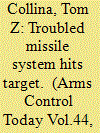

|
|
|
|
|
| Publication |
2014.
|
| Summary/Abstract |
The problem-plagued missile defense system designed to protect the United States from potential attacks from North Korea and Iran successfully intercepted a target missile last month, clearing the way for the Obama administration to move ahead with its plans to expand the system.
In the June 22 test, a ground-based interceptor (GBI) missile launched from Vandenberg Air Force Base in California collided with an intermediate-range ballistic missile target launched from the Army's Kwajalein Test Site in the Marshall Islands, according to a Missile Defense Agency (MDA) press release.
|
|
|
|
|
|
|
|
|
|
|
|
|
|
|
|
| 9 |
ID:
132784
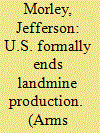

|
|
|
|
|
| Publication |
2014.
|
| Summary/Abstract |
The U.S. government announced on June 27 that it will not produce or acquire anti-personnel landmines and that it intends to join the global Mine Ban Treaty at some point in the future, a stance that did not satisfy activists and officials pressing to rid the world of landmines.
The U.S. government is "diligently pursuing…solutions that would be compliant" with the treaty and "that would ultimately allow us to accede" to it, Douglas Griffiths, the U.S. ambassador to Mozambique, said in a statement delivered at a review conference for the treaty being held in Maputo. The parties to the treaty, which entered into force in 1999, hold these conferences every five years.
Supporters of the treaty voiced disappointment throughout the conference that the United States has yet to join the treaty, which President Barack Obama endorsed as a U.S. senator in 2007. Although U.S. officials told reporters that their review of U.S. landmine policy, which began five years ago, is not completed, the announced changes fell short of proponents' hopes for U.S. accession to the treaty.
|
|
|
|
|
|
|
|
|
|
|
|
|
|
|
|
| 10 |
ID:
132789
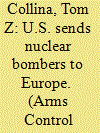

|
|
|
|
|
| Publication |
2014.
|
| Summary/Abstract |
The U.S. Air Force sent five nuclear-capable bombers to Europe in early June as President Barack Obama traveled to the region to reassure allies against the backdrop of Russia's recent annexation of Crimea and separatist conflict in Ukraine.
All five bombers went to the air force base at Fairford in the United Kingdom. Two B-52 bombers from Barksdale Air Force Base in Louisiana and one from Minot Air Force Base in North Dakota arrived on June 4 for a two-week deployment, according to an Air Force press release. "Airmen will train and integrate with U.S. and allied military forces in the region," the Air Force said, adding that the bombers did not carry live weapons.
Four days later, two B-2 bombers based at Whiteman Air Force Base in Missouri flew to Fairford as well, the Air Force said. As the most sophisticated U.S. bomber for penetrating enemy air defenses, the presence in Europe of nuclear-capable B-2s was reported by media outlets as possibly sending a pointed message to Moscow.
|
|
|
|
|
|
|
|
|
|
|
|
|
|
|
|
|
|
|
|
|